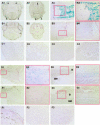Transgenic mice expressing a ligand-inducible cre recombinase in osteoblasts and odontoblasts: a new tool to examine physiology and disease of postnatal bone and tooth
- PMID: 15579432
- PMCID: PMC1618706
- DOI: 10.1016/S0002-9440(10)63240-3
Transgenic mice expressing a ligand-inducible cre recombinase in osteoblasts and odontoblasts: a new tool to examine physiology and disease of postnatal bone and tooth
Abstract
The skeleton supports body structures in vertebrates and helps maintain calcium homeostasis throughout life. Disruption of genes involved in mammalian bone formation has often led to embryonic lethality, hence preventing study of these genes' role in adult animals. To develop a usable tool for such study, we generated transgenic mice in which a 2.3-kb mouse Col1a1 proximal promoter, which is active in all osteoblasts, drives a transgene coding for a polypeptide consisting of Cre recombinase fused to a mutated ligand-binding domain of the estrogen receptor. In this Col1a1-CreERT2 mouse line, expression patterns of the transgene and of the resulting Cre-mediated DNA recombination are analyzed by crossing with ROSA26 reporter mice and by measurement of beta-galactosidase activity and X-gal staining. Exposure to 4-hydroxytamoxifen induced Cre-mediated recombination in osteoblasts in virtually all bones and in odontoblasts in teeth of both embryos and postnatal mice. The generation of these transgenic mice provides a new and important tool with which to study the function of specific genes in bone and tooth physiology and diseases in intact animals after birth.
Figures





Similar articles
-
Odontoblast-specific expression of cre recombinase successfully deletes gene segments flanked by loxP sites in mouse teeth.Genesis. 2003 Feb;35(2):94-9. doi: 10.1002/gene.10170. Genesis. 2003. PMID: 12533791
-
Mouse alpha1(I)-collagen promoter is the best known promoter to drive efficient Cre recombinase expression in osteoblast.Dev Dyn. 2002 Jun;224(2):245-51. doi: 10.1002/dvdy.10100. Dev Dyn. 2002. PMID: 12112477
-
Controlling gene expression in the urothelium using transgenic mice with inducible bladder specific Cre-lox recombination.J Urol. 2002 Dec;168(6):2641-4. doi: 10.1016/S0022-5347(05)64235-8. J Urol. 2002. PMID: 12442001
-
Endothelial-Specific Cre Mouse Models.Arterioscler Thromb Vasc Biol. 2018 Nov;38(11):2550-2561. doi: 10.1161/ATVBAHA.118.309669. Arterioscler Thromb Vasc Biol. 2018. PMID: 30354251 Free PMC article. Review.
-
Sites of Cre-recombinase activity in mouse lines targeting skeletal cells.J Bone Miner Res. 2021 Sep;36(9):1661-1679. doi: 10.1002/jbmr.4415. Epub 2021 Aug 22. J Bone Miner Res. 2021. PMID: 34278610 Review.
Cited by
-
Downregulation of CFIm25 amplifies dermal fibrosis through alternative polyadenylation.J Exp Med. 2020 Feb 3;217(2):e20181384. doi: 10.1084/jem.20181384. J Exp Med. 2020. PMID: 31757866 Free PMC article.
-
CC-Chemokine Receptor-2 Expression in Osteoblasts Contributes to Cartilage and Bone Damage during Post-Traumatic Osteoarthritis.Biomolecules. 2023 May 26;13(6):891. doi: 10.3390/biom13060891. Biomolecules. 2023. PMID: 37371471 Free PMC article.
-
Proximity-Based Differential Single-Cell Analysis of the Niche to Identify Stem/Progenitor Cell Regulators.Cell Stem Cell. 2016 Oct 6;19(4):530-543. doi: 10.1016/j.stem.2016.07.004. Epub 2016 Aug 11. Cell Stem Cell. 2016. PMID: 27524439 Free PMC article.
-
A BAC-based transgenic mouse specifically expresses an inducible Cre in the urothelium.PLoS One. 2012;7(4):e35243. doi: 10.1371/journal.pone.0035243. Epub 2012 Apr 9. PLoS One. 2012. PMID: 22496911 Free PMC article.
-
Mouse Cre-LoxP system: general principles to determine tissue-specific roles of target genes.Lab Anim Res. 2018 Dec;34(4):147-159. doi: 10.5625/lar.2018.34.4.147. Epub 2018 Dec 31. Lab Anim Res. 2018. PMID: 30671100 Free PMC article. Review.
References
-
- Aszodi A, Bateman JF, Gustafsson E, Boot-Handford R, Fassler R. Mammalian skeletogenesis and extracellular matrix: what can we learn from knockout mice? Cell Struct Funct. 2000;25:71–82. - PubMed
-
- Mundlos S, Olsen BR. Heritable diseases of the skeleton. Part I: molecular insights into skeletal development-transcription factors and signaling pathways. FASEB J. 1997;11:125–132. - PubMed
-
- Mundlos S, Olsen BR. Heritable diseases of the skeleton. Part II: molecular insights into skeletal development-matrix components and their homeostasis. FASEB J. 1997;11:227–233. - PubMed
-
- Capecchi MR. The new mouse genetics: altering the genome by gene targeting. Trends Genet. 1989;5:70–76. - PubMed
-
- Rossant J, McMahon A. “Cre”-ating mouse mutants—a meeting review on conditional mouse genetics. Genes Dev. 1999;13:142–145. - PubMed
Publication types
MeSH terms
Substances
Grants and funding
LinkOut - more resources
Full Text Sources
Other Literature Sources
Molecular Biology Databases
Research Materials
Miscellaneous

